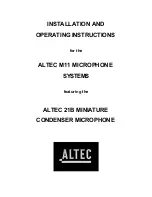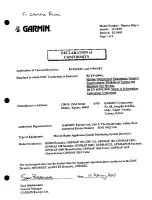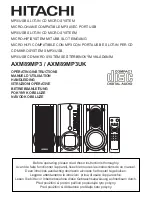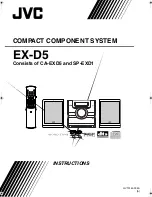
F I G U R E A
DISCUSSION OF M11 MICROPHONE SYSTEM
COMPONENTS AND THEIR FUNCTIONS
ALTEC 21 B MICROPHONE
A cross-section diagram showing essential electrical
and mechanical portions of the 21B Microphone is
shown in Figure C. The essential parts, electrically,
consist of a diaphragm and an electrode or backplate
in close proximity. The backplate and diaphragm being
closely spaced constitute an electrical capacitance which
varies with microscopic mechanical deflection of the
diaphragm caused by pressure variations in the sound
wave. The backplate or center terminal is polarized with
respect to the diaphragm through a very high resistance
so that a fixed charge accumulates on the center termi-
nal. As the sound pressure causes the capacity of the
microphone to vary, the voltage between the center
terminal and diaphragm also varies, the resulting signal
being applied to the grid of a vacuum tube.
The surface of the diaphragm adjacent to the center
terminal is formed of insulating material, eliminating
the problem of electrical breakdown between these
parts. The function of the inner shield which surrounds
the center terminal is described in the discussion of the
150A Base.
THE 150A MICROPHONE BASE
The 150A Microphone Base encloses a vacuum tube
whose function is to translate the voltage generated at
extremely high impedances by the microphone to a
nearly equal voltage at low impedance so that the signal
can be faithfully transmitted over lengths of cable to
subsequent apparatus. The circuit of the impedance
translating tube in the 150A Base is shown in Figure
D. The microphone backplate receives its polarization
through the elevation of cathode voltage above ground
potential. It is a property of the cathode follower
circuit that its input impedance is extremely high whereas
its output impedance is low. Also the effect of any
capacity connected between cathode and grid is
greatly reduced by the cathode follower action. Con-
nection of the inner shield in this manner permits the
microphone to be separated by a short distance from
the vacuum tube. The extension between tube and
microphone is intended to take the fullest advantage of
the diminutive size of the microphone by furnishing a
minimum visual and acoustical obstacle size.



























